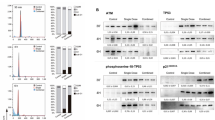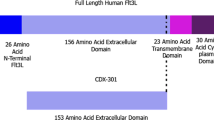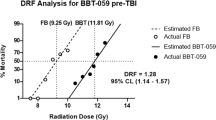Abstract
Ataxia telangiectasia is a genetic instability syndrome characterized by neurodegeneration, immunodeficiency, severe bronchial complications, hypersensitivity to radiotherapy and an elevated risk of malignancies. Repopulation with ATM-competent bone marrow-derived cells (BMDCs) significantly prolonged the lifespan and improved the phenotype of Atm-deficient mice. The aim of the present study was to promote BMDC engraftment after bone marrow transplantation using low-dose irradiation (IR) as a co-conditioning strategy. Atm-deficient mice were transplanted with green fluorescent protein-expressing, ATM-positive BMDCs using a clinically relevant non-myeloablative host-conditioning regimen together with TBI (0.2–2.0 Gy). IR significantly improved the engraftment of BMDCs into the bone marrow, blood, spleen and lung in a dose-dependent manner, but not into the cerebellum. However, with increasing doses, IR lethality increased even after low-dose IR. Analysis of the bronchoalveolar lavage fluid and lung histochemistry revealed a significant enhancement in the number of inflammatory cells and oxidative damage. A delay in the resolution of γ-H2AX-expression points to an insufficient double-strand break repair capacity following IR with 0.5 Gy in Atm-deficient splenocytes. Our results demonstrate that even low-dose IR results in ATM activation. In the absence of ATM, low-dose IR leads to increased inflammation, oxidative stress and lethality in the Atm-deficient mouse model.
This is a preview of subscription content, access via your institution
Access options
Subscribe to this journal
Receive 12 print issues and online access
$259.00 per year
only $21.58 per issue
Buy this article
- Purchase on Springer Link
- Instant access to full article PDF
Prices may be subject to local taxes which are calculated during checkout





Similar content being viewed by others
Change history
06 April 2015
This paper was modified 12 months after initial publication to switch to Creative Commons licence terms, as noted at publication
References
Gatti RA, Becker-Catania S, Chun HH, Sun X, Mitui M, Lai CH et al. The pathogenesis of ataxia-telangiectasia. Learning from a Rosetta Stone. Clin Rev Allergy Immunol 2001; 20: 87–108.
Reichenbach J, Schubert R, Schindler D, Muller K, Bohles H, Zielen S . Elevated oxidative stress in patients with ataxia telangiectasia. Antioxid Redox Signal 2002; 4: 465–469.
Chun HH, Gatti RA . Ataxia-telangiectasia, an evolving phenotype. DNA Repair (Amst) 2004; 3: 1187–1196.
McGrath-Morrow SA, Gower WA, Rothblum-Oviatt C, Brody AS, Langston C, Fan LL et al. Evaluation and management of pulmonary disease in ataxia-telangiectasia. Pediatr Pulmonol 2010; 45: 847–859.
Micol R, Ben Slama L, Suarez F, Le Mignot L, Beaute J, Mahlaoui N et al. Morbidity and mortality from ataxia-telangiectasia are associated with ATM genotype. J Allergy Clin Immunol 2011; 128: 382–9.e1.
Lavin MF, Gueven N, Bottle S, Gatti RA . Current and potential therapeutic strategies for the treatment of ataxia-telangiectasia. Br Med Bull 2007; 81-82: 129–147.
Brazelton TR, Rossi FM, Keshet GI, Blau HM . From marrow to brain: expression of neuronal phenotypes in adult mice. Science 2000; 290: 1775–1779.
Kahler CM, Wechselberger J, Hilbe W, Gschwendtner A, Colleselli D, Niederegger H et al. Peripheral infusion of rat bone marrow derived endothelial progenitor cells leads to homing in acute lung injury. Respir Res 2007; 8: 50.
Priller J, Persons DA, Klett FF, Kempermann G, Kreutzberg GW, Dirnagl U . Neogenesis of cerebellar Purkinje neurons from gene-marked bone marrow cells in vivo. J Cell Biol 2001; 155: 733–738.
Pietzner J, Baer PC, Duecker RP, Merscher MB, Satzger-Prodinger C, Bechmann I et al. Bone marrow transplantation improves the outcome of Atm-deficient mice through the migration of ATM-competent cells. Hum Mol Genet 2013; 22: 493–507.
Bagley J, Cortes ML, Breakefield XO, Iacomini J . Bone marrow transplantation restores immune system function and prevents lymphoma in Atm-deficient mice. Blood 2004; 104: 572–578.
Buckley RH . Bone marrow and thymus transplantation in ataxia-telangiectasia. Birth Defects Orig Artic Ser 1975; 11: 421–424.
Ghosh S, Schuster FR, Binder V, Niehues T, Baldus SE, Seiffert P et al. Fatal outcome despite full lympho-hematopoietic reconstitution after allogeneic stem cell transplantation in atypical ataxia telangiectasia. J Clin Immunol 2012; 32: 438–440.
Ussowicz M, Musial J, Duszenko E, Haus O, Kalwak K . Long-term survival after allogeneic-matched sibling PBSC transplantation with conditioning consisting of low-dose busilvex and fludarabine in a 3-year-old boy with ataxia-telangiectasia syndrome and ALL. Bone Marrow Transplant 2013; 48: 740–741.
Gluckman E, Devergie A, Schaison G, Bussel A, Berger R, Sohier J et al. Bone marrow transplantation in Fanconi anaemia. Br J Haematol 1980; 45: 557–564.
MacMillan ML, Hughes MR, Agarwal S, Daley GQ . Cellular therapy for fanconi anemia: the past, present, and future. Biol Blood Marrow Transplant 2011; 17: S109–S114.
Gruhn B, Seidel J, Zintl F, Varon R, Tonnies H, Neitzel H et al. Successful bone marrow transplantation in a patient with DNA ligase IV deficiency and bone marrow failure. Orphanet J Rare Dis 2007; 2: 5.
Albert MH, Gennery AR, Greil J, Cale CM, Kalwak K, Kondratenko I et al. Successful SCT for Nijmegen breakage syndrome. Bone Marrow Transplant 2010; 45: 622–626.
Bitan M, Or R, Shapira MY, Aker M, Resnick IB, Ackerstein A et al. Fludarabine-based reduced intensity conditioning for stem cell transplantation of Fanconi anemia patients from fully matched related and unrelated donors. Biol Blood Marrow Transplant 2006; 12: 712–718.
MacMillan ML, Wagner JE . Haematopoeitic cell transplantation for Fanconi anaemia - when and how? Br J Haematol 2010; 149: 14–21.
Medeiros C, Zanis-Neto J, Pasquini R . Bone marrow transplantation for patients with Fanconi anemia: reduced doses of cyclophosphamide without irradiation as conditioning. Bone Marrow Transplant 1999; 24: 849–852.
Yabe H, Inoue H, Matsumoto M, Hamanoue S, Koike T, Ishiguro H et al. Allogeneic haematopoietic cell transplantation from alternative donors with a conditioning regimen of low-dose irradiation, fludarabine and cyclophosphamide in Fanconi anaemia. Br J Haematol 2006; 134: 208–212.
Taylor AMR, Byrd PJ . Molecular pathology of ataxia telangiectasia. J Clin Pathol 2005; 58: 1009–1015.
Barlow C, Hirotsune S, Paylor R, Liyanage M, Eckhaus M, Collins F et al. Atm-deficient mice: a paradigm of ataxia telangiectasia. Cell 1996; 86: 159–171.
Okabe M, Ikawa M, Kominami K, Nakanishi T, Nishimune Y . 'Green mice' as a source of ubiquitous green cells. FEBS Lett 1997; 407: 313–319.
Zierhut HA, Tryon R, Sanborn EM . Genetic counseling for Fanconi anemia: crosslinking disciplines. J Genet Couns 2014; 23: 910–921.
Undarmaa B, Kodama S, Suzuki K, Niwa O, Watanabe M . X-ray-induced telomeric instability in Atm-deficient mouse cells. Biochem Biophys Res Commun 2004; 315: 51–58.
Wolden SL, Rabinovitch RA, Bittner, Nathan HJ, Galvin JM, Giap HB et al. American College of Radiology (ACR) and American Society for Radiation Oncology (ASTRO) practice guideline for the performance of total body irradiation (TBI). Am J Clin Oncol 2013; 36: 97–101.
Thakar MS, Kurre P, Storb R, Kletzel M, Frangoul H, Pulsipher MA et al. Treatment of Fanconi anemia patients using fludarabine and low-dose TBI, followed by unrelated donor hematopoietic cell transplantation. Bone Marrow Transplant 2011; 46: 539–544.
Pollard JM, Gatti RA . Clinical radiation sensitivity with DNA repair disorders: an overview. Int J Radiat Oncol Biol Phys 2009; 74: 1323–1331.
Hada M, Huff JL, Patel ZS, Kawata T, Pluth JM, George KA et al. AT cells are not radiosensitive for simple chromosomal exchanges at low dose. Mutat Res 2011; 716: 76–83.
Kiuru A, Kamarainen M, Heinavaara S, Pylkas K, Chapman K, Koivistoinen A et al. Assessment of targeted and non-targeted responses in cells deficient in ATM function following exposure to low and high dose X-rays. PLoS ONE 2014; 9: e93211.
Rübe CE, Grudzenski S, Kühne M, Dong X, Rief N, Löbrich M et al. DNA double-strand break repair of blood lymphocytes and normal tissues analysed in a preclinical mouse model: implications for radiosensitivity testing. Clin Cancer Res 2008; 14: 6546–6555.
Nakamura H, Yasui Y, Saito N, Tachibana A, Komatsu K, Ishizaki K . DNA repair defect in AT cells and their hypersensitivity to low-dose-rate radiation. Radiat Res 2006; 165: 277–282.
Short SC, Bourne S, Martindale C, Woodcock M, Jackson SP . DNA damage responses at low radiation doses. Radiat Res 2005; 164: 292–302.
Suzuki K, Okada H, Yamauchi M, Oka Y, Kodama S, Watanabe M . Qualitative and quantitative analysis of phosphorylated ATM foci induced by low-dose ionizing radiation. Radiat Res 2006; 165: 499–504.
Ghafoori P, Marks LB, Vujaskovic Z, Kelsey CR . Radiation-induced lung injury. Assessment, management, and prevention. Oncology (Williston Park) 2008; 22: 37–47 discussion 52-3.
Kataoka T . Study of antioxidative effects and anti-inflammatory effects in mice due to low-dose X-irradiation or radon inhalation. J Radiat Res 2013; 54: 587–596.
Reichenbach J, Schubert R, Schwan C, Muller K, Bohles HJ, Zielen S . Antioxidative capacity in patients with common variable immunodeficiency. J Clin Immunol 2000; 20: 221–226.
Schubert R, Erker L, Barlow C, Yakushiji H, Larson D, Russo A et al. Cancer chemoprevention by the antioxidant tempol in Atm-deficient mice. Hum Mol Genet 2004; 13: 1793–1802.
Eickmeier O, Kim SY, Herrmann E, Doring C, Duecker R, Voss S et al. Altered mucosal immune response after acute lung injury in a murine model of Ataxia Telangiectasia. BMC Pulm Med 2014; 14: 93.
Boder E . Ataxia-telangiectasia: some historic, clinical and pathologic observations. Birth Defects Orig Artic Ser 1975; 11: 255–270.
Herzog EL, Chai L, Krause DS . Plasticity of marrow-derived stem cells. Blood 2003; 102: 3483–3493.
Hess DC, Hill WD, Carroll JE, Borlongan CV . Do bone marrow cells generate neurons? Arch Neurol 2004; 61: 483–485.
Alvarez-Dolado M, Pardal R, Garcia-Verdugo JM, Fike JR, Lee HO, Pfeffer K et al. Fusion of bone-marrow-derived cells with Purkinje neurons, cardiomyocytes and hepatocytes. Nature 2003; 425: 968–973.
Diaz D, Munoz-Castaneda R, Alonso JR, Weruaga E . Bone marrow-derived stem cells and strategies for treatment of nervous system disorders: many protocols, and many results. Neuroscientist 2014; 21: 637–652.
Perlman S, Becker-Catania S, Gatti RA . Ataxia-telangiectasia: diagnosis and treatment. Semin Pediatr Neurol 2003; 10: 173–182.
Amariglio N, Hirshberg A, Scheithauer BW, Cohen Y, Loewenthal R, Trakhtenbrot L et al. Donor-derived brain tumor following neural stem cell transplantation in an ataxia telangiectasia patient. PLoS Med 2009; 6: e1000029.
Jones J, Jaramillo-Merchan J, Bueno C, Pastor D, Viso-Leon M, Martinez S . Mesenchymal stem cells rescue Purkinje cells and improve motor functions in a mouse model of cerebellar ataxia. Neurobiol Dis 2010; 40: 415–423.
Acknowledgements
We would like to thank Katrin Krug and Heike Korff for her technical assistance. The authors would also like to acknowledge support from a Loewe grant (LOEWE Center for Cell and Gene Therapy Frankfurt funded by Hessisches Ministerium für Wissenschaft und Kunst (HMWK) oder ‘Hessian Ministry of Higher Education, Research and the Arts’ funding reference number: III L 4- 518/17.004 (2010)).
Author information
Authors and Affiliations
Corresponding author
Ethics declarations
Competing interests
The authors declare no conflict of interest.
Rights and permissions
About this article
Cite this article
Pietzner, J., Merscher, B., Baer, P. et al. Low-dose irradiation prior to bone marrow transplantation results in ATM activation and increased lethality in Atm-deficient mice. Bone Marrow Transplant 51, 560–567 (2016). https://doi.org/10.1038/bmt.2015.334
Received:
Revised:
Accepted:
Published:
Issue Date:
DOI: https://doi.org/10.1038/bmt.2015.334



